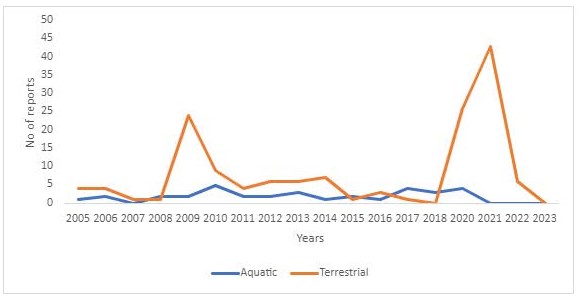Perspectives Posted on 2023-12-12 11:46:05
WOAH actions
The importance of notification of emerging diseases
Keywords
Authors
Paolo Tizzani *, Bernita Giffin, Stian Johnsen
World Organisation for Animal Health (WOAH)
*Corresponding author, Paolo Tizzani
In addition to the 117 terrestrial and aquatic listed diseases, WOAH Members have an obligation to report information on diseases of particular epidemiological relevance, even if they do not fit the criteria listed in Chapter 1.2 of the Terrestrial Animal Health Code and the Aquatic Animal Health Code.
An emerging disease is defined in the Codes as ‘a new occurrence in an animal of a disease, infection or infestation, causing a significant impact on animal or public health resulting from: i) a change of a known pathogenic agent or its spread to a new geographic area or species; or ii) a previously unrecognised pathogenic agent or disease diagnosed for the first time’.
The process to evaluate and assess whether a disease should be considered as emerging is described here.
According to Article 1.1.4 of the Terrestrial Animal Health Code and the Aquatic Animal Health Code, if an emerging disease occurs, the Veterinary Authorities in that country shall send to WOAH, through the World Animal Health Information System (WAHIS), an immediate notification and periodic follow-up reports. The submission of these reports is critical to enabling a better understanding of the epidemiology of the disease and its importance for animal and public health.
In contrast to the report for listed diseases, Members do not have the obligation to submit an alert report 24 hours after disease confirmation.
Since 2005, WOAH has recognised 29 emerging diseases (13 aquatic diseases and 16 terrestrial diseases). Some emerging diseases were later included in the list of reportable diseases (e.g. infection with decapod iridescent virus 1). In 2022, WOAH recognised four emerging diseases: three aquatic diseases (carp edema virus, Enterocytozoon hepatopenaei infection and Tilapia lake virus disease) and one terrestrial disease (SARS-CoV-2 in animals).
The occurrence of emerging diseases is reported through WAHIS. Between 2005 and September 2022, there were 178 immediate notification reports (144 for terrestrial diseases and 34 for aquatic diseases). The trend of report submission is presented in Figure 1. The peak of reports in 2021 was due to SARS-CoV-2 in animals and the peak in 2009 to swine influenza H1N1.
These two examples highlight the fact that EIDs are a major animal and public health concern, and emphasise the importance of reporting to WAHIS and the significance of a One Health approach that includes human, animal and environmental health monitoring.

https://doi.org/10.20506/bull.2023.2.3407
References
- Morens, D.; Folkers, G.K.; Fauci, A.S. The challenge of emerging and re-emerging infectious diseases. Nature 2004, 430, 242–249.
- McArthur, D.B. Emerging Infectious Diseases. Nurs. Clin. N. Am. 2019, 54, 297–311.
- Jones, K.E.; Patel, N.G.; Levy, M.A.; Storeygard, A.; Balk, D.; Gittleman, J.L.; Daszak, P. Global trends in emerging infectious diseases. Nature 2008, 451, 990–993.












